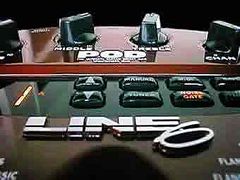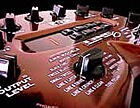| |
|
 |
Since
its introduction, more than two decades ago, the digital technology
spreaded into the pro-audio market, but the manufacturers faced many
difficulties to enter the guitar amplifiers field. The ultimate technology
takes advantage of the increased calculation speed and memory capabilities
of the new digital systems. So, it is now possible to reproduce the
original sound generation of the analog circuits. The more sophisticated
and modern systems feature a dedicated computer, that virtually emulates
the amplifier, speakers and recording microphones tonal characteristics.
The Line6 plug-in Amp Farm software has been the first effective tool
dedicated to emulation purposes. At the beginning, the software was
just available for the Pro Tools users. After the big success obtained
by this software, Line6 decided to release a stand-alone unit, including
the same built-in features and independent from a computer connection:
this unit is the POD. |
| |
|
| |
 POD
controls and I/O POD
controls and I/O
 POD
version 2 implementations POD
version 2 implementations
 POD
XT
enhancements POD
XT
enhancements
 POD
/
POD Pro features POD
/
POD Pro features
 Bass
POD
/
Bass POD Pro features Bass
POD
/
Bass POD Pro features
 Pedalboards
features Pedalboards
features
|
| MAIN
PLUS |
|
 |
 |
Convenience.
The POD allows a direct connnection to a linear amplification system
(i.e.: live concert large-scale PA systems or home hi-fi stereo) in
order to reproduce at a low volume the same sound of a complete guitar
system. Line6 developed the A.I.R. technology (Acoustically Integrated
Recording) that faithfully emulates the interaction of amplifier,
cabinet, speakers, microphone and environment. The system is really
user-friendly: you have just to connect the line outputs (mono or
stereo) for starting a recording session or to perform a live gig.
Many problems can be eliminated such as sonic pressure, too high volumes,
microphone choice and positioning, feedback, etc.
Flexibility. The POD emulates the distinctive sound of 32 amplifier
models, including the '50 and '60 Fender vintage, the classic Vox
and Marshall, the contemporary Soldano, Mesa Boogie, Matchless, Dumble
and so on. A wide range of onboard digital effects is also provided:
wha, chorus, flanger, tremolo, delay, reverb, leslie. The simulation
is based on the well-known original Vox, Boss, ADA and Fender effects.
Although each selected amplifier is matched with the original cabinet,
a wide range of customized solutions can be obtained, combining different
cabinets and amplifier models in order to achieve new timbral variations
(1x8, 1x12, 2x10, 2x12, 4x10, 4x12 speaker models simulation is included).
The POD can also be used as a preamplifier. Switching off the A.I.R
function, the unit can be directly connected to a guitar amplifier
or to a power unit with closed or open cabinet. On the other hand,
the BASS POD provides 16 amplifier models, digital effects such as
compressor, octaver, chorus, flanger, phaser, envelope filter, synth,
wha and a full range of bass cabinets.
Memories and MIDI control. The POD provides 9 Banks each one
including 4 memories ("channels", according to the classic terminology
of the traditional amplifiers). The 36 memories can be recalled directly,
via MIDI or thru the dedicated Line6 FLOOR BOARD. Each memory can
store amplifier model, settings, effects with relevant parameters
and cabinet model. All parameters can be MIDI controlled thru the
preset Line6 Control Changes map (the map cannot be modified).
Audio Quality. The POD provides a very realistic amp simulation
and high quality sounds. The unit can be useful in any professional
application (studio recording or live gigs). Moreover, once a model
has been selected, the knobs become the original amplifier potentiometers.
This feature suggests the use of the POD as a teaching tool. The only
limitation we pointed out is a slight delay of the output signal,
due to the processing time. The delay can be perceived just selecting
the clean sounds provided from some amplifier model. Moreover, selecting
more aggressive or distorted sounds, this delay cannot be absolutely
perceived. |
| |
|
| USER
INTERFACE |
|
 |

(Note:
LCD available on POD XT only) |
Editing.
Operation is really user-friendly: after selecting an amplifier model
thru the relevant knob, any setting can be done as with an usual amplifier.
The effects and data settings can be saved into an internal memory.
Recalling a program, the original knobs setting could not match the
actual memory knobs position.
In this case, anyway, it is possible to set the knobs to their memory
position thru the LED indicators. To make more easy this job, the
POD XT features an additional graphic display showing direcly the
knob current positions. |
| |
Software.
Line6 supplies an Emagic SoundDiver (MIDI units Editor) dedicated
software version. Available for both platforms PC and Mac, this software
gives access to a range of parameters not directly available on the
unit. The software provides a Program library and allows to use the
POD in Re-Amping applications. In this case, it is possible to record
a clean guitar sound and to process it later during the mixdown, in
order to obtain the same kind of sound provided by the Amp Farm software.
In spite of the further possibilities offered by the software, the
POD is a stand-alone unit, that doesn't require any computer connection.
|
| |
Line6
optional pedalboards. The Line6 remote pedalboards are POD-series
full-compatible accessories (FlooBoard and FB4 models). |
| |
|
| CONCLUSION |
|
 |
| |
For
what concerns the digital technology applied to the guitar sound,
there's no doubt that the POD started a new age of positive thinking.
Obviously, being a copy, the POD is not like the original: true amplifiers,
a well-equipped studio, high quality and well positioned microphones
and a good engineer can provide more recording possibilities and,
maybe, a better sound quality. Nevertheless, considering its price,
the POD offers a lot: wherever you need a compact size and low weight
tool, providing easy volume, effects and tone control and flexible
tonal characteristics, the POD is an effective solution, enjoyable
and user-friendly. |
| |
|
|
 |



